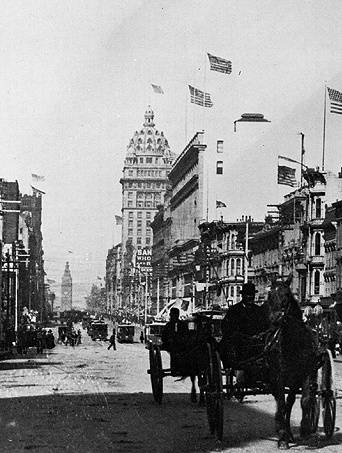THE CALL BUILDING: SAN FRANCISCO'S FORGOTTEN SKYSCRAPER
Call Building 1997
Like many historic buildings, the Claus Spreckels ("Call") Building no longer exists except in photographs or in the hand-tinted images of turn-of-the-century postcards. Its magnificent domed presence once dominated a city skyline that has long since disappeared.
But unlike most forgotten landmarks, the Call Building still remains. Its interior has been gutted and redone, its exterior completely changed, yet the pale stone tower at the corner of Third and Market Streets is still standing, ninety-four years after it first opened its doors.
Today it seems as modern and nondescript as a hundred other buildings. But in its basement there are massive stone arches, mosaic tiles on the floor of a storage bin, and rosebud friezes on the high ceiling. On the upper floors office doors boast bronze doorknobs ornately monogrammed with the initials "CS."
These are the only clues that the Call Building has not always been what it seems, that once an unknown admirer had written:
"It is, per se, a beautiful building--that is the unanimous verdict. After that it is imposing, magnificent, costly, a pride to San Francisco, a monument to the good taste and enterprise of its owner and builder, Claus Spreckels; the greatest newspaper building in the world, the handsomest of tall buildings, the tallest of the tall buildings west of Chicago--all these things and more; but first, last and all the time, it is the most beautiful building."CALL BUILDING 1906: BURNED BUT STANDING 1
In September of 1895, the first ceremonial shovel of sand was removed from a 70 feet x 75 feet lot at the corner of Third and Market Streets. The site of the old Johnson House Building had been purchased in April of that year, and the former structure torn down to make way for a modern office building that would be a monument to its multi-millionaire owner, ALASKA COMMERCIAL CORPORATION Claus Spreckels.2
PROGRESS AND REMODELING
The Call Building had survived the earthquake and fire, but in the 1930s it faced an enemy even more destructive--progress. Some of the sandstone on the upper floors needed to be repaired or replaced, but rather than restore the forty-year-old landmark to its prime, its owners decided to remodel it into a more modern, efficient, and economical building.
Architect Albert Roller drew up plans to change the classic domed tower into a Moderne block, with twenty-one full stories of usable, rentable office space.
With no architectural heritage societies, preservationists, or concerned citizens to decry the loss, scaffolding and hoist-cages were erected in September of 1937. Preparations were made for removing "the uneconomical top stories" (the dome). Piece by piece the terra cotta ornaments were removed and discarded. By November the dome was half gone, as if some giant knife had cut it in two; by January of 1938 there was no dome at all.
Steel work extended the square sides of the building up to form a slightly inset cube, six stories high. The decorative friezes, columns, arched windows, and other "inefficient" ornamentation were removed, and the whole building was refaced with a cream-colored concrete, creating a severe, unadorned vertical shaft which was critically acclaimed as a feat of remodeling.
The interior offices and corridors were also "modernized" (although the doorknobs in the older portion of the building still bear the "CS" monogram; interior stairs are marble and wrought iron up to the 16th floor, and steel and concrete beyond). The most striking interior change was the entrance and lobby. The arches and columns that fronted on Market Street were removed and the first three floors were faced with dark, polished granite. An entrance with a Moderne grill led into a lobby with polished black marble floors, bronze Art Deco motif elevators and curved walls of glass brick.14
In the fall of 1938 the remodeling of the Call Building into the Central Tower was completed. The building still stands at the corner of Third and Market Streets.
Once proclaimed the tallest building for thousands of miles and the "handsomest commercial edifice in the world," in the space of a few decades the Call Building went from being one of the most prominent structures in the country to being just another downtown building. For most San Franciscans, the Call Building is just a piece of history, perhaps a fond memory; many have never heard of it at all. Some assume the Humboldt Building, which retained its dome and character, was once the Call. Few would suspect the Central Tower of having such a spectacular past.
--by Ellen Klages, excerpted from a longer article originally published in The Argonaut, Summer 1993, Volume 4, Number 1
Call Building 1902
Contributors to this page include:
Carlsson,Chris - Photographer-Artist
Green - Publisher or Photographer
Argonaut - Publisher or Photographer
Klages,Ellen - Writer
Argonaut - Publisher or Photographer
Klages,Ellen - Writer
Ferry Building description Prev. Document CALL BUILDING 1906: BURNED BUT STANDING Next Document


